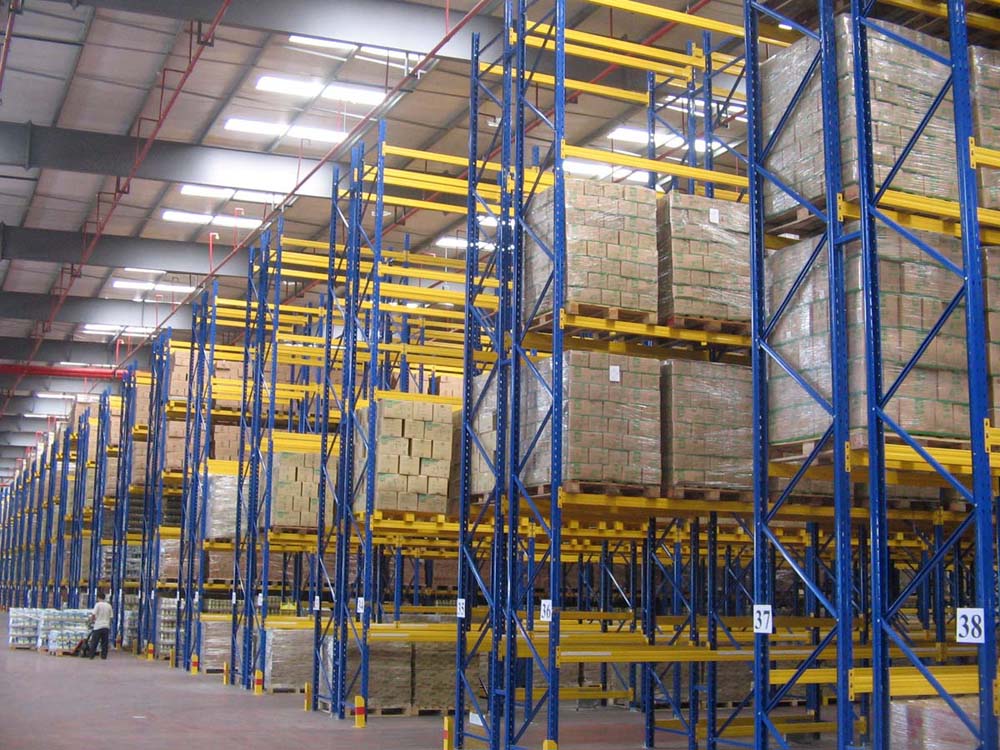In modern warehouse management, heavy-duty pallet racking stands as the core equipment of industrial storage systems. With its high load capacity, compatibility, and flexible scalability, it has become an “efficiency engine” for manufacturing, logistics, and retail industries. This article explores its core advantages, applications, and selection guidelines to help you optimize storage space and enhance operational efficiency.
I. Structure and Features of Heavy-Duty Pallet Racking
- Basic Structure
Composed of upright frames, beams, decking, and safety accessories, it is manufactured from high-strength cold-rolled or hot-rolled steel. Single-layer load capacity reaches 2,000-5,000 kg, meeting heavy-duty storage needs.
- Upright Frames: C-shaped or U-shaped cross-sectional design with excellent compression and bending resistance.
- Beams: Adjustable height to accommodate various pallet sizes (e.g., Euro, US standard pallets).
- Decking: Optional mesh panels or steel plates for enhanced ventilation and load stability.
- Core Advantages
- Ultra-High Space Utilization: Maximizes vertical space, supporting rack heights over 10 meters with forklift access.
- Flexible Adaptability: Adjustable shelf heights and spans to fit diverse cargo dimensions.
- Enhanced Safety: Standard safety features include collision guards and column protectors to minimize equipment impact risks.
II. Typical Applications
- Manufacturing Industry
- High-density storage for automotive parts, machinery, and heavy materials.
- Supports FIFO (First-In-First-Out) or FILO (First-In-Last-Out) management models.
- Cold Chain Logistics
- Low-temperature-resistant steel designs for food/pharmaceutical pallet storage in cold storage environments.
- E-commerce Warehousing
- Integration with automated equipment (e.g., AGVs, stacker cranes) for efficient picking and replenishment.
III. Selection Guide: How to Choose the Right Racking?
- Evaluate Warehouse Conditions
- Floor Load Capacity: Ensure ground pressure ≥ full-load pressure of racks.
- Space Dimensions: Measure ceiling height and column spacing to plan layouts (e.g., single-row, double-row, drive-in).
- Analyze Cargo Properties
- Weight & Size: Select beam specifications and decking thickness based on per-pallet weight.
- Access Frequency: High-frequency zones may require drive-in racks or narrow-aisle designs.
- Budget & Scalability
- Prioritize modular designs for future expansion or layout adjustments.
IV. Maintenance & Care Recommendations
- Regular Inspections: Quarterly checks on bolt tightness and upright alignment; replace deformed components promptly.
- Rust Prevention: Apply anti-corrosion coatings or use galvanized steel in humid environments.
- Safe Operations: Strictly avoid overloading; mark safety distance zones for forklift operations.
V. Future Trends: Smart & Sustainable Solutions
- Smart Warehousing Integration
- Monitor rack status and synchronize inventory data via WMS (Warehouse Management Systems).
- Enhance cargo tracking efficiency with RFID technology.
- Eco-Friendly Upgrades
- Use recyclable steel to reduce carbon footprints; adopt lightweight structures to minimize material consumption.
Conclusion
Heavy-duty pallet racking is not just storage equipment but a strategic asset for cost reduction and efficiency improvement. Proper selection and maintenance can extend rack lifespans by 10+ years, ensuring long-term supply chain competitiveness. For customized solutions, consult professional warehouse planning teams to optimize designs based on on-site assessments.
